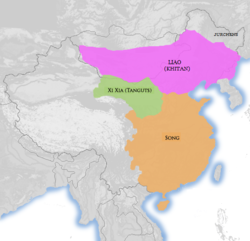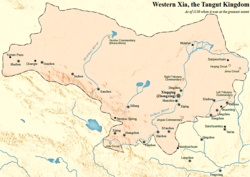
Back Westelike Xia Afrikaans شيا الغربية Arabic Imperiu tangut AST Si Sya Azerbaijani باتی شیا سولالهسی AZB Заходняе Ся Byelorussian Западна Ся Bulgarian Тангуд улас BXR Imperi Tangut Catalan Să̤-hâ CDO
Great Xia | |||||||||||||||||||
|---|---|---|---|---|---|---|---|---|---|---|---|---|---|---|---|---|---|---|---|
| 1038–1227 | |||||||||||||||||||
 Location of Western Xia in 1111 (green in north west) | |||||||||||||||||||
 Western Xia in 1150 | |||||||||||||||||||
| Capital | Xingqing (modern Yinchuan) | ||||||||||||||||||
| Common languages | |||||||||||||||||||
| Religion | |||||||||||||||||||
| Government | Monarchy | ||||||||||||||||||
| Emperor | |||||||||||||||||||
• 1038–1048 | Emperor Jingzong | ||||||||||||||||||
• 1139–1193 | Emperor Renzong | ||||||||||||||||||
• 1226–1227 | Li Xian (final) | ||||||||||||||||||
| Historical era | Post-classical history | ||||||||||||||||||
• Rebellion by Li Jiqian against the Song dynasty | 984 | ||||||||||||||||||
• Dynasty established by Emperor Jingzong | 1038 | ||||||||||||||||||
• Subjugation by the Mongol Empire | 1210 | ||||||||||||||||||
• Destruction by the Mongol Empire | 1227 | ||||||||||||||||||
| Area | |||||||||||||||||||
| 1100 est.[1] | 1,000,000 km2 (390,000 sq mi) | ||||||||||||||||||
| Population | |||||||||||||||||||
• peak | 3,000,000[2][3][4] | ||||||||||||||||||
| Currency | Barter, copper coins[5][better source needed] See Western Xia coinage | ||||||||||||||||||
| |||||||||||||||||||

| Part of a series on the |
| History of China |
|---|
The Western Xia or the Xi Xia (Chinese: 西夏; pinyin: Xī Xià; Wade–Giles: Hsi1 Hsia4), officially the Great Xia (大夏; Dà Xià; Ta4 Hsia4), also known as the Tangut Empire, and known as Mi-nyak[6] to the Tanguts and Tibetans, was a Tangut-led Buddhist imperial dynasty of China that existed from 1038 to 1227. At its peak, the dynasty ruled over modern-day northwestern China, including parts of Ningxia, Gansu, eastern Qinghai, northern Shaanxi, northeastern Xinjiang, and southwest Inner Mongolia, and southernmost Outer Mongolia, measuring about 800,000 square kilometres (310,000 square miles).[7][8][9]
The capital of Western Xia was Xingqing (modern Yinchuan); another major Xia city and archaeological site is Khara-Khoto. Western Xia was annihilated by the Mongols in 1227. Most of its written records and architecture were destroyed, so the founders and history of the empire remained obscure until 20th-century research in China and the West. Today the Tangut language and its unique script are extinct, only fragments of Tangut literature remain.
The Western Xia occupied the area around the Hexi Corridor, a stretch of the Silk Road, the most important trade route between northern China and Central Asia. They made significant achievements in literature, art, music, and architecture, which was characterized as "shining and sparkling".[10] Their extensive stance among the other empires of the Liao, Song, and Jin was attributable to their effective military organizations that integrated cavalry, chariots, archery, shields, artillery (cannons carried on the back of camels), and amphibious troops for combat on land and water.[11]
- ^ Turchin, Peter; Adams, Jonathan M.; Hall, Thomas D. (December 2006). "East-West Orientation of Historical Empires". Journal of World-Systems Research. 12 (2): 222. ISSN 1076-156X. Retrieved 16 September 2016.
- ^ Kuhn, Dieter (15 October 2011). The Age of Confucian Rule: The Song Transformation of China. Harvard University Press. p. 50. ISBN 9780674062023.
- ^ Bowman, Rocco (2014). "Bounded Empires: Ecological and Geographic Implications in Sino-Tangut Relations, 960-1127" (PDF). The Undergraduate Historical Journal at UC Merced. 2: 11. doi:10.5070/H321025689.
- ^ McGrath, Michael C. Frustrated Empires: The Song-Tangut Xia War of 1038-44. In Wyatt. p. 153.
- ^ Chinaknowledge.de Chinese History - Western Xia Empire Economy. 2000 ff. © Ulrich Theobald. Retrieved: 13 July 2017.
- ^ Stein (1972), pp. 70–71.
- ^ Wang, Tianshun [王天顺] (1993). Xixia Zhan Shi [The Battle History of Western Xia] 《西夏战史》. Yinchuan [银川], Ningxia ren min chu ban she [Ningxia People's Press] 宁夏人民出版社.
- ^ Bian, Ren [边人] (2005). Xixia: xiaoshi zai lishi jiyi zhong de guodu [Western Xia: the kingdom lost in historical memories] 《西夏: 消逝在历史记忆中的国度》. Beijing [北京], Waiwen Chubanshe [Foreign Languages Press] 外文出版社.
- ^ Li, Fanwen [李范文] (2005). Xixia tong shi [Comprehensive History of Western Xia] 西夏通史. Beijing [北京] and Yinchuan [银川], Ren min chu ban she [People's Press] 人民出版社; Ningxia ren min chu ban she [Ningxia People's Press] 宁夏人民出版社.
- ^ Zhao, Yanlong [赵彦龙] (2005). "Qian tan xi xia gong wen wen feng yu gong wen zai ti [A brief discussion on the writing style in official documents and documental carrier] 浅谈西夏公文文风与公文载体." Xibei min zu yan jiu [Northwest Nationalities Research] 西北民族研究 45(2): 78-84.
- ^ Qin, Wenzhong [秦文忠], Zhou Haitao [周海涛] and Qin Ling [秦岭] (1998). "Xixia jun shi ti yu yu ke xue ji shu [The military sports, science and technology of West Xia] 西夏军事体育与科学技术." Ningxia Daxue Xuebao [Journal of Ningxia University] 《宁夏大学学报》 79 (2): 48-50.
© MMXXIII Rich X Search. We shall prevail. All rights reserved. Rich X Search